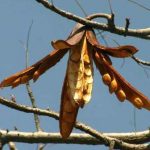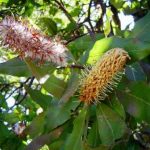TREE LIFE
October 1985
MASHONALAND CALENDAR
Tuesday October 1st: Botanic Garden Walk, meet at 1645 for 1700hours
Sunday October 20th: Hidden Valley, Mazowe. Hidden Valley, the home of Mr. and Mrs. Morley, although recently sold, has a delightful collection of large trees, particularly excellent specimens of three fig species, and also both riverine and kopje habitats. This promises to be a rewarding trip, close to town and shaded in case we need to cope with the October sun blasting. We will share transport so please meet at the Monomatapa Car Park at 0845 to leave at 0900 hours.
PROPOSED MANA POOLS WEEKEND: Friday April 11th to Monday April 1th 1986, alternate Thursday April 10th to Sunday April 13th 1986.
With Mana Pools Wildlife Safaris at Rukomechi Camp run by Garth Thomson. Cost $225 per person to cover all meals, teas, laundry, guided walks, canoeing, game drives, night drives and the 15% Government Sales Tax. This is a special offer. It does not however include the cost of getting to Mana which can be arranged once we have confirmed that the trip is definitely on.
In order to make a firm booking we need to know that we have 16 people who wish to make this trip and their cheques not later than October 20th. Cheques should be payable to the Tree Society of Zimbabwe and sent to Meg Coates Palgrave, P.O.Box 4643, Harare or 12 Kariba Crescent Hillside.
MATABELELAND CALENDAR
On Sunday October 6th :We will go to the Matopos, Mtsheleli Valley Area. Meet at Retreat at 0830 hours.
NOTES
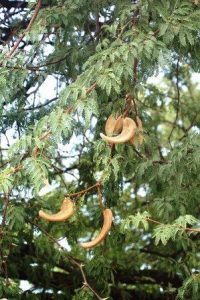
Acacia erioloba. Photo: Bart Wursten. Source: Flora of Zimbabwe
On Sunday September 1st we went to Woodcroft Ranch, just in the Nyamandhlovu District, by kind permission of Mr. and Mrs. J. P. Simpson. This is on Kalahari Sand, mixed with stony kopjes, so, whilst we did not see many species, some 30 plus, in all, they were a bit different from our usual, near Bulawayo. We saw some big Acacia erioloba, with plenty of characteristic pods, many Acacia galpinii, already flowering, some showing the red purple calyces, some fully opened, Acacia nilotica also flowering, some small Acacia nigrescens, not flowering, although near Bulawayo they were. Albizia amara, Azanza garckeana, Bauhinia thonningii, Bridelia mollis, Cassia abbreviata, flowering, Clerodendrum glabrum, Colophospermum mopane, this far from typical, being on the lower well drained slopes of a kopje with very pointed leaflets, causing myself, among other, to think that it might be Guibourtia, but the bark and vestigial leaflets were definite; many Combretum imberbe, a few Combretum hereroense, Commiphora mollis, square stemmed, Dalbergia melanoxylon, many Diospyros mespiliformis, Dombeya rotundifolia flowering, Euclea divinorum, leaves rather small, Ficus ingens, and what was probably Ficus burkei, Grewia retinervis, with very grooved stems, Maytenus heterophylla, Pterolobium stellatum, with big thorny bosses, a few Sclerocarya birrea, Terminalia sericea, some large leaved Terminalia, perhaps T. mollis as the pods I saw were not red, Tetradenia brevispicata, this courtesy of Brian Best; Iboza is now Tetradenia, and var. Riparia, apparently not in our area, Ximenia caffra, Ziziphus mucronata.
-C. Sykes,
BOTANIC GARDEN WALK : 3RD SEPTEMBER 1985
The Celastrales : The order Celastrales is a collection of families which appear to be related, and yet are not easily characterized. Amongst the indigenous families, this group includes the CELASTRACEAE, HIPPOCRATEACEAE, SALVADORACEAE, AQUIFOLIACEAE, ICACINACEAE and DICHAPETALACEAE. I must add that this is according to Cronquist. In the Engler and Prantl system DICHAPETACACEAE fit alongside the EUPHORBIACEAE, but then Cronquist puts EUPHORBIACEAE next to the Celastrales anyway. Besides having simple leaves and small flowers I have difficulty relating these families using vegetative features. The leaves may be opposite or alternate, entire or serrated, and usually they don’t produce tannin.
Two families are not represented in the gardens, the SALVADORACEAE and DICHAPETALACEAE. The SALVADORACEAE is the mustard tree family but this is not the plant which was likened to the kingdom of the heavens, Matt. 13:31, that tree in which the birds of the heavens found lodgings, was really a herb belonging to the cabbage genus, Brassica nigra. Apparently it can become an overgrown herb of 3 meters or so. The real mustard tree, Salvadora persica as well as S. angustifolia are lowveld species. We saw a number of bushy specimens on the alluvial sands alongside the Runde River at Gonarezhou.
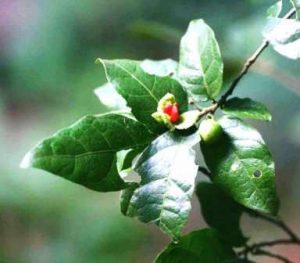
Tapura fischeri. Photo: Bart Wursten. Source: Flora of Zimbabwe
The DICHAPETALACEAE contains Tapura fischeri. This forest tree has flowers which appear to emerge from the top of the leaf petiole. This family often produces highly poisonous compounds.
The first and last plants which we examined on the walk belonged to the ICACINACEAE. I must confess to having scrabbled around the Halleria numerous times collecting flowers or berries and never noticed the small Cassinopsis tinifolia in front of it. Tom says it grows to 10m or so in the rainforests on the upper slopes of Mt. Inyangani but he could not find any seedlings here. The only regeneration seems to occur in early pioneer vegetation amongst Hypericum and Philippia above the tea estates. This round bush ranges in altitude from between 1200 – 2000 m. The other ICACINACEAE which we saw much later in the gloaming was Apodytes dimidiata. We usually recognize it by its shiny, leathery, alternate leaves with entire but wavy margins and long, pink petioles. It grows in marginal rainforest in granite kopjes and along rivers. They proved hardy during the drought. I do not have a mental image of the ICACINACEAE but apparently, they often accumulate aluminium, may produce cyanide and may contain crystals.
The largest family in the order is the CELASTRACEAE whose leaves are characteristically glabrous. We examined four of the indigenous genera; Cassine, Pleurostylia, Maytenus and Catha. Cassine leaves are distinctive, hard and dark green with sharp serrations. Of our five species, the leaves of C. transvaalensis are fascicled, in C. aethiopica they are alternate and in the rest they are opposite. Just to the right of Cassinopsis we found Cassine papillosa with waxy looking yellow berries which, judging from Phil’s grimace, are not recommended as they dry the mouth out. This species may grow to 30 m in the Vumba where it is identified by its orange under bark which may show through. Crossing the lawn and passing the Gardenia resiniflua we found the lowveld C. schlechteriana. In the dry season this is one of the few dark green trees. Meg had found a number of specimens while canoeing down the Zambezi the previous week and so thence followed a vivid field impression including a drawing of the curved, swan’s neck petioles. We reviewed the other species as well; C. transvaalensis stands on anthills and in granite kopjes and is aggressively serrated when juvenile; C. matabelica has opposite leaves and C. aethiopica has alternate leaves and grows on granite kopjes and riverine fringes, it can get very tall in rain forests.
Near the Dovyalis zeyheri we found Pleurostylia africana with small green capsules. This is common in miombo woodland and granite kopjes, remember the large specimens at the Marr Levins?
The local Maytenus are less of a headache now, but they used to be. M. undata as always confused with Cassine and looking for black glands on the tips of the serrations proved tedious. Now we simply rub the underside and smell, the stale, waxy smell which assaults your nose is identical to that of the top tier from the Haxen’s wedding cake which, as tradition has it doubles up as a christening cake, but tradition does not bargain on as many years in a cupboard. A bottle of brandy did something to the cake – we have not tried it on Maytenus yet. We found M. senegalensis with grey leaves and pink petioles. I remember one recce when Pat ended up with her fair filled with these tiny white flowers while she tried to collect a few sprays. These flowers attract the flies from miles away, no, not the flowers in Pat’s hair, the flowers on the tree.

Catha edulis . Photo: Bart Wursten. Source: Flora of Zimbabwe
Moving over to the top of the high-altitude forest we found Maytenus heterophylla with sharp lateral spurs and small leaves. This species is very variable and thus confusing. Possibly we will look at the other Maytenus species next month. Making our way around to look at the tall Catha edulis which look like gum trees standing at the top of the new stream. This is the khat which is a narcotic and as a result trade in khat leaves has been banned in various countries. Tom’s trees keep their leaves, as the drug is less effective in our trees. It is a pioneer tree in dry rainforests and is common on Cecil Kop.
We examined three species of Hippocratea, a genus sometimes combined with CELASTRACEAE and sometimes kept separate in the HIPPOCRATEACEAE. Alongside Cassine papillosa was a creeping H. africana demonstrating the long shoots with short suppressed lateral branches in an opposite decussate arrangement. These branches twist and curl as soon as they touch anything. This species has distinct white lenticels, no orange on the bark, a shiny leaf with few serrations and grows in the Vumba and Mt. Selinda. Behind C. schlechteriana we found H. longipetiolata with long petioles, very few serrations and drooping leaves. It comes from alluvial sands in the Save Valley and Sanyati. Behind this again we found H. buchananii with very soft velvety leaves which droop down now in the dry season. This species grows on schist on the escarpment. Although not on the tree list officially this plant is often more of a shrub than a creeper.
We must thank Tom once again for such an informative walk and for putting up with all of our nonsense, especially our constant distractions. We must comment on the Acacia hebeclada at the pond in full flower and filling the air with that distinctive smell of Acacia roots. This subsp. chobiensis comes from above Victoria Falls.
-Kim ST.J. Damstra
HERBARIUM NOTES ON GONAREZHOU
Amongst the question marks was Cleistochlamys kirkii identified by its small and ANNONACEAE gland dots on the leaf. There was also a Maerua parvifolia which looked just like Boscia foetida to me, although apparently M. parvifolia is a smaller shrub.
FROM CHIPINDA POOLS AND HILLSIDE WALK: The trifoliate Vitex with sessile leaflets was V. isotjensis, the other one was, questionably, V. payos. The composite herb in amongst the rocks of the Runde River on the way to the waterfall was Pluchea dioscoridis. The small, round leaved Ochna with small serrations and yellow leaves which we found while running to catch up with the party that did not go to the waterfall was O. inermis, at the top of a steep incline. The spiny Dovyalis just behind the camp on the path to the worker’s hut was D. hispidula as we had guessed.
THE OUTING TO CHILOJO CLIFFS: Manilkara concolor was confirmed and this was the first collection of flowering specimens for this country. Positive identification of Rhinorrhea elliptica; Brian Best apparently boiled up the pressed flower to check this. Also, beneath the Chlorophora was a Tricalysia which Tom collected, and it was identified as Neoroseaasminiflora. The Euclea from the sands behind Chilojo was E. natalensis subsp. angustifolia. Near the view point we also found Canthium setiflorum.
LONE STAR RANCH: The spiny Rhus below the dam wall in the riverbed with very shiny leaves was Rhus queinzii var spinescens. Despite the many differences and as much as it seems wrong, all the problem Strychnos specimens are still S. spinosa, but Tom now has this growth form in the gardens so next time someone wants to review the genus this will be noticed.
CHEGUTU OUTING TO BURNBANK FARM, 8TH SEPTEMBER 1985
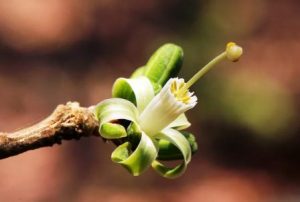
Turraea nilotica. Photo: Bart Wursten. Source: Flora of Zimbabwe
A SMALL GROUP MET ON Burnbank Farm, but small is also friendly and we had a happy day. We started off looking at a fair sized Ficus sur, making a point of feeling the leaves for later comparisons, and noting the reddish tint on the newer shoots, the tree was in full leaf. The bunches of figs hanging from the trunk and larger branches were eye catching, with some of the fruit quite red already – these had to be tasted of course, and the parasitisation of many was noted. Nearby we found an almost leafless Grewia monticola with shaggy parasitized fruit, that and the photocopy-notes on Grewia helped us to identify with the few leaves, with markedly asymmetric bases almost fitted the copied example exactly, thank you MCP. The trunk of this specimen was easily ankle thick and well over our heads. Across the road we looked at a small leaved, small fruited fig? Ficus burkei – the leaves and fruit are so variable that I am at a loss- could it be F. thonningii, one of the strangler types, and the birds love the fruit, blue starlings and Meyer’s parrots especially. (F. burkei = F. thonningii now, so its much easier than it used to be, simply as no one understands them – ED) Syzygium quineense subsp. quineense in bright fresh green caught the eye with typical misshapen inflorescences; we did find a few healthy flower buds forming to compare with the gall smitten ones, what a lovely garden subject this tree would be if it were not for this susceptibility! The next highlight, after a disappointingly near bare Ficus nigropunctata, at least we believe it is that, was a Turraea nilotica in full flower with that long protruding style, what pollinates the flower? We wondered. Also in honey scented bloom were the Brachystegia spiciformis, to me a scent evocative of childhood and bee keeping father. Later we refreshed our memories on the differences between Masasa and Munondo when we found two trees growing almost arm in arm. A short drive to the banks of a small dam, where the two littlest members of our party were fascinated by the water lilies and added more seeds of Terminalia sericea and Lonchocarpus capassa to their collections. The latter was in new leaf but not yet in flower and growing in a seepage area below the dam, could not be seen to be ‘raining’ yet. Along the path we stopped to examine Hexalobus monopetalus with unopened flower buds already waiting in the leaf axils. Across the dam more specimens of the small-leafed fig, then a fine Ficus sycomorus with yellowed trunk, and harsh, large, rounded leaves. This one was not in full fruit, which the cattle almost queue for to eat; the dry leaves are also relished by them. In the rocks nearby we puzzled over a large tree, leafless with bark flaking in large blotches, and a great thick root creeping across the rock in fig like fashion, and then a pod was spotted high up – Afzelia quanzensis of course! Azanza garckeana was also growing in the rocks and an old fruit was found to be added to the seed collection. Another fig, thonningii, shaded a complete circle of secret quiet coolth among the rocks, but the little people were getting tired, so we moved on to find Friesodielsia obovata showing that it can grow to tree size. And then a leafless Commiphora delighted one of our learners’ heart, C. mossambicensis she cried, Kim had impressed her with the description of the wrinkled, toffee effect where the short branches came off the main trunk. Ozoroa insignis was an old friend to another, the first name she had ever learnt, with its especially individual leaf. Euphorbia matabelensis were tree size and in bud, overshadowed by a tall seed bearing Pterocarpus angolensis and Lannea discolor in bud, its trunk reddish tinted and rubbery looking. And then on to Vangueriopsis lanciflora also in flower vividly demonstrating the meaning of the name with its long buds. On the drive back to the farmhouse we passed more Afzelia, assorted Combretums, and a lovely Kigelia africana in flower, game and cattle like to eat the flowers that fall to the ground; mixed Brachystegia woodland, with Mopane along the vleis. There were more trees to see, but all, and not only the 2 and 4 years old, were tired by then, and we finished our treeing, after picnicking under a palm tree in the garden, with a look at the budding six-year-old Schotia brachypetala and Bolusanthus speciosus. In our area we have noticed that Bolusanthus seems to grow naturally on the heavier soils, especially the dyke types, rather than on sandveld, so we are very pleased with our garden specimen, and glad to share it with fellow tree lovers. Yes, it was a happy day, and we felt we had all learnt from one another.
-Ann Bianchi
OUTING TO PETERHOUSE CONSERVATION PROJECT GOSHA PARK, SPRINGVALE : 15TH SEPTEMBER 1985
Peter Ginn, well known and highly respected conservationist and ornithologist, hosted a party of Tree Society members from Harare and Marondera. The full bus was testimony to the pre-trip patter which had evidently whetted many appetites.
Upon arrival, we heard of the background and history of the park, the fencing, dams, the introduced game, birds, trails, the plan of labelling trees, the labels affixed so that they also serve as trail markers, boreholes projected, picnic areas, plans as to gum plantations and so forth.
With that introduction, the party split into three groups, each guided by some of the Peterhouse lads involved in the project and took different routes along trails to the dam, our common destination. We started off in Brachystegia woodland admiring the wide spectrum of colour in the newly flushed leaves of the masasa, Brachystegia spiciformis, ranging from burgundy red, through pinks, oranges, browns and greens. A little later we stopped to consider the differences between this and the oft confused munondo, Julbernardia globiflora. It was too early for new leaves on the munondo, so that’s the first difference. But looking at the compound leaves of both species one observes that there are fewer leaflets on masasa, usually about four pairs, while munondo regularly has twice that number. Masasa has its largest leaflets as the terminal pair, and these have the habit of waving at one in the breeze. Munondo has its largest leaflets half way along the leaf’s length. Then there is a general furriness about munondo, on the leaves and especially the pods. This is mainly absent in masasa. Also, the flowers and pods on munondo are generally borne sticking out above the canopy of the tree, whilst this is not apparent in masasa.
Conspicuous in the under storey with new fresh green leaf was Rhus longipes. The tri-foliate leaf and roundish leaflets with entire margins offer the main clues to its identity. The crisp smell from the crushed leaf should also help. Also common in this area was Uapaca kirkiana, the mahobohobo or mazhanje, easily recognized by the outsized leaves, dry and brittle in texture, which when fallen to earth crunch like corn flakes underfoot to the chagrin of would-be stealthy hunters.
Soon encountered was Combretum molle. The “combretum” part is usually solved by the occurrence of four winged fruit. The “molle” part will certainly be resolved once one feels the soft velvet leaves.
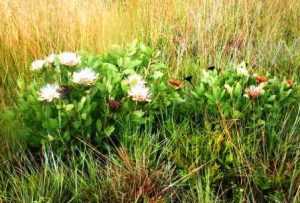
Protea angolensis. Photo: Bart Wursten. Source: Flora of Zimbabwe
A common find was Protea angolensis the first member of one of three “triumvirates” seen during the day, for we saw all the Protea of our area during the day. This is the broad leafed one with the pink petiole. The leaf is not hairy. The other two are narrow leafed without the pink petiole. They differ in that one is furry or velvety. This P. welwitschii, velvety, welwity. The other P. gaquedi is smooth leafed usually.
The second triumvirate was that of the Erythrinas Meg was confident of having seen E. latissima and pointed out the worm like arrangement stamens of the part of the flower. We also saw the common E. abyssinica, while for me the discovery, in the bush, of E. lysistemon was immensely satisfying, even though we all know it from urban gardens. This, which we found in a rocky area, shows no sign of the worms protruding out of the flower. We also noted the much smoother bark of this tree. Later, on the bus home, we were able to note how often one sees an Erythrina in red flower in close proximity with a white flowering Dombeya rotundifolia, also seen at Springvale.
The third triumvirate of the day was Cussonia. I did not actually see C. arborea on this occasion, but it is present, we saw it on our recce. This is the common Highveld species where the leaf actually separates into distinct, but simple leaflets. We did see C. spicata which is more of a forest tree. In this case the leaflets themselves are palmately compound. The specimens had plenty of leaf. Not so in the case of C. natalensis, these were mostly leafless and just starting to grow fresh inflorescences. However, one or two old leaves were located. These leaves do not separate into leaflets, they are merely deeply lobed, with radial veins. It is unusual to find all three species together, so we relished the opportunity to compare them.
Large green grapefruit sized fruit on a smallish tree with smooth bark sufficed to identify S. spinosa. In this general area were a number of small Parinari curatellifolia, well known for its occasional bad smell like an open sewer. The veins on the simple leaves are characteristically parallel coming off the mid rib almost at right angles. The lower side of the leaf is slightly velvety and paler than the upper side. The discovery of floes on a tree seen in the afternoon prompted Kim to perform an impromptu dissection to demonstrate that the tree is distantly related to a rose.
Coming to the edge of a vlei we found what, in retrospect must have been Syzygium quineense in new fruit, for it at least had a little petiole. On the other side of the vlei was S. cordatum without doubt. A petiole was altogether absent with the lobes of the leaf base almost encircling the stem.
In this area we first encountered my “mystery” tree. The simple alternative leaves with a slight gloss failed to stir my memory until I was told later. It was Apodytes dimidiata, again more common as a forest or riverine fringe tree, last seen at the Marr Levins in July.
Crossing through a lie of low kopjes we found the first of many Diospyros whyteana. They were indeed a refreshing sight, with a shiny wet look to the leaves. Around the edge of the leaf is a delicate halo of small hairs. Whilst none were in fruit as such many had the remains of the persistent calyx which so encapsules the fruit that it earns itself the name “bladder nut”. Another glossy customer, though not in quite the same class, was Dovyalis zeyheri. For once we did not stand around guessing for ages, because almost every second leaf bore the tell-tale racetrack left by the excavations of the leaf miner so often associated with this tree.
(I have a feeling that there is a page missing, but it is not to be found. I presume these notes were written by Kim Damstra.- Mary Lovemore)
-KIM DAMSTRA Acting Chairman


